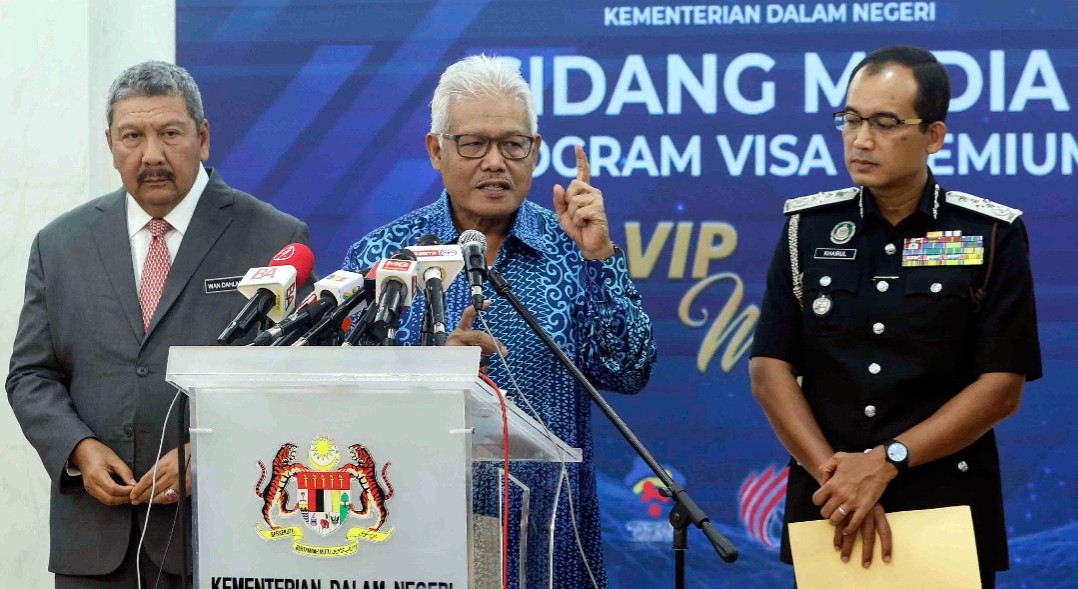The government announced that on the first day of its new Premium Visa Investment Programme, 20,000 applications were received. Not everyone is buying that story, however.
Just four days after announcing the new Premium Visa Programme (PVIP), a supposed “residency through investment” scheme with no actual investment required, just a hefty participation fee, Home Minister Hamzah Zainudin has already boldly declared the programme a massive winner.
The premium visa programme has been a huge success, with the Home Ministry receiving 20,000 applications from agents on the first day of its launch, according to the Minister.
“I would like to inform that for the first phase, we have set a limit of no more than 25,000 applications,” he told reporters, not specifying what time frame that limit would cover. He also noted that the Ministry may raise the participation fees in the next phase.
A comprehensive search of the Home Ministry’s website, which presumably was the portal for at least some of these 20,000 applications received, yielded no results for any information whatsoever about PVIP, nor any way to apply. It was unclear which “agents” were being referenced in the Home Minister’s comments.
Official documents detailing the programme have not been made available, to the best of our knowledge, only the announcement about the programme’s launch. PVIP will commence on October 1.
The “residency through investment” programme is meant to attract “business tycoons” to Malaysia. However, successful applicants to this investment programme will not actually be required to invest in Malaysia, beyond parking at least RM1 million in a savings account and paying a RM200,000 “participation fee” for the principal applicant and RM100,000 for each dependent. Proof of at least RM40,000 per month or RM480,000 per year in offshore income is also required.
If you’re thinking this sounds a lot like the new MM2H requirements, just with the addition of far higher upfront costs, you’re not alone.
One difference is that PVIP offers a 20-year visa, though in reality it would likely be a five-year visa, with three subsequent renewals. (No visa in Malaysia may legally be longer than five years.) At each five-year mark, we are told participants would need to undergo medical check-ups and a police check.
We spoke with a number of people who, while understandably not keen to go on record openly bashing the government, nevertheless had some pointed questions and comments.
Many expressed confusion over the initial announcement, as the PVIP programme has very similar requirements to the current MM2H programme. Like MM2H, the PVIP also offers no path to citizenship or permanent residency, and no express guarantee of residency was mentioned, either.
Here’s why that is problematic: To anyone familiar with the saga of visa-holding MM2Hers being shut out of Malaysia for many months during the pandemic, despite often having their only home here, a visa with no guaranteed right of residency is of questionable value since the current or future government can choose to simply not honour the visa and deny entry to those holding it, as was exactly the case with MM2H visa holders.
Moreover, for “business tycoons” who really wish to legitimately invest in Malaysia, there are of course already paths for them to do so. Those who start businesses in the country can apply for — and usually be granted — regular work visas, without the enormous upfront costs.
Now, with the Home Ministry’s latest claim of 20,000 applicants on the programme’s first day, that confusion has turned to outright skepticism.
“Is this number even feasible?” one man asked. “Has the programme been marketed overseas at all? I don’t think this number is accurate.”
“This claim seems extremely unlikely,” another remarked. “They said they were targeting 1,000 participants a year, and now they’re saying they got 20,000 applications on the first day? How? How did so many people apply to this programme that even we in Malaysia know very little about?”
Indeed, nobody we spoke with — from Malaysians to expats to stakeholders involved with MM2H and even business leaders — believed the claim of 20,000 PVIP applicants in one day.
MM2H Consultants Association President Anthony Liew had doubts even about the target of 1,000 participants for the PVIP programme, saying he felt it was rather high, “given the already slow take-up rate for MM2H itself.”
Zerin Properties Group CEO Previndran Singhe seemed to agree, noting that a highly competitive global market for programmes like this meant it would require some time for Malaysia to effectively plan and implement PVIP for a wider reach, which, in his words, made the targeted 1,000 participants in the first year a highly ambitious goal.
“For context, as of June 2017, the Singapore Global Investor Program, which offers permanent residency to those who qualify, granted 1,826 applicants the status of permanent residents since its inception in 2004.
“Of these, 67 of them have received citizenship,” he said.
It’s worth noting again that Malaysia’s PVIP offers no path to permanent residency and certainly no chance of citizenship. Yet in just one day, according to the Home Minister, Malaysia has received 20,000 applicants, while Singapore has gotten less than 1,900 in 13 years.
"ExpatGo welcomes and encourages comments, input, and divergent opinions. However, we kindly request that you use suitable language in your comments, and refrain from any sort of personal attack, hate speech, or disparaging rhetoric. Comments not in line with this are subject to removal from the site. "



















